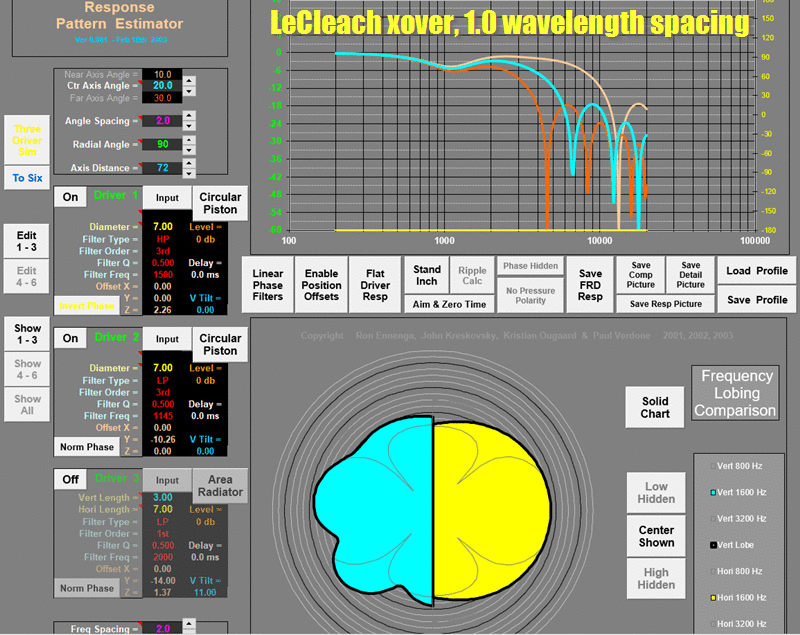I would say, in a typical combination of direct-radiating woofer and horned tweeter, designed with the goal of good transient response, group delay of hipass is around half of the one of lopass. Looking at plots of the original post, you see phase difference between lo- and hipass belo cross-over point. Therefore one may use two woofers embracing one tweeter, as Joe D'Appolito suggested. As frequencies go even lower, phase difference matters less, as hipass amplitude is fading.
I favour a second-order lo- and a first-order hipass, and then, as frequencies go even higher, phase difference between hi- and lopass shows up, too, but again one branch becomes that quiet, that the cross-over works.
I favour a second-order lo- and a first-order hipass, and then, as frequencies go even higher, phase difference between hi- and lopass shows up, too, but again one branch becomes that quiet, that the cross-over works.
While tinkering with LeCleach crossovers, I was pleasantly surprised by how they allow for very wide spacing between the elements.
I'm accustomed to conventional crossovers, where you frequently see very deep nulls off-axis, so the behavior of the LeCleach crossover was a surprise!
I wanted to see how far I could take it, so I did some sims.
In these sims, I'm simulating an 8" woofer with a waveguide of approximately 8". I am varying the center to center spacing, starting at 1.0 wavelength (10.26") and going all the way down to 0.7 wavelength (7.18")
The crossover point is fixed at 1316Hz, the highpass is at 1500Hz, the lowpass is at 1145Hz and the tweeter is set back 2.26". All of this is based on the recommendations from the LeCleach crossover paper. Note that the highpass and the lowpass are staggered, that's why there's a dip at the xover frequency.

Here's the horizontal polar response

Here's the vertical polar response
I'm accustomed to conventional crossovers, where you frequently see very deep nulls off-axis, so the behavior of the LeCleach crossover was a surprise!
I wanted to see how far I could take it, so I did some sims.
In these sims, I'm simulating an 8" woofer with a waveguide of approximately 8". I am varying the center to center spacing, starting at 1.0 wavelength (10.26") and going all the way down to 0.7 wavelength (7.18")
The crossover point is fixed at 1316Hz, the highpass is at 1500Hz, the lowpass is at 1145Hz and the tweeter is set back 2.26". All of this is based on the recommendations from the LeCleach crossover paper. Note that the highpass and the lowpass are staggered, that's why there's a dip at the xover frequency.

Here's the horizontal polar response

Here's the vertical polar response
...I was pleasantly surprised by how they allow for very wide...
I'm accustomed to conventional crossovers, where you frequently see very deep nulls off-axis, so the behavior of the LeCleach crossover was a surprise!...
Hi John, everyone
A post by Marco prompted me to revisit this thread and I see I missed those replies more than a year after my post.
You are observant to notice this about the LeCleac'h, I just read a JAES paper by Lipshitz and Vanderkooy and they discuss polar sensitivity in some detail.
I still haven't taken that all in yet but I do better understand some of the questions I asked in 2015.
Anyone still interested in this?
Best wishes
David
I have a great interest in quasi-optimal crossovers. Using a BSS 3 ways digital processor, I tried many of the configurations which are presented here : filtre "quasi-optimal" : modeles et variantes - Le blog de jimbeeHi John, everyone
Anyone still interested in this?
Jimbee is member here as Jmbee.
I have...
Nice to have at least one response.
What is the context, is it a broad interest in crossovers or a specific application, presumably with horns?
I ask because it has occurred to me that some of the theory is also applicable to Danley-style Multi Entry Horns and there is a lot of interest in them.
So I may start a new thread to tie to that interest base.
Best wishes
David
The concept of the quasi-optimal crossovers has been applied to all kinds of loudspeakers. Jean-Michel Le Cleac'h who made them popular in France used them with his horns. The availability of digital FIR crossovers made them somewhat droped.Nice to have at least one response.forr said:I have a great interest in quasi-optimal crossovers. Using a BSS 3 ways digital processor, I tried many of the configurations which are presented here : filtre "quasi-optimal" : modeles et variantes - Le blog de jimbee
Jimbee is member here as Jmbee.
What is the context, is it a broad interest in crossovers or a specific application, presumably with horns?
I ask because it has occurred to me that some of the theory is also applicable to Danley-style Multi Entry Horns and there is a lot of interest in them.
So I may start a new thread to tie to that interest base.
The concept of the quasi-optimal crossovers has been applied to all kinds of loudspeakers...
I meant what was your interest, did you just want to do a specific crossover or were you interested in the theory itself?
In any case - I have started a new thread Crossover and time delay/offset, for horns particularly. but not much interest yet.
This is a pity because I have some results that are quite neat.
Phase linearization is possible.
Best wishes
David
- Status
- This old topic is closed. If you want to reopen this topic, contact a moderator using the "Report Post" button.
- Home
- Loudspeakers
- Multi-Way
- "Quasi-optimal" crossover for high-efficiency loudspeaker system